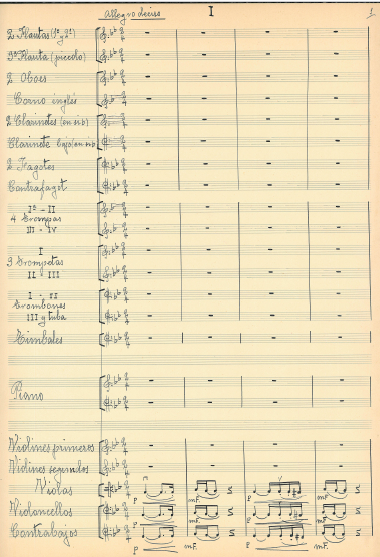
Allegro deciso
Concerto for piano and orchestra (1953)
Handwritten copy. Family property.
Concert recording: https://www.youtube.com/watch?v=UVCLYvl6W00
Date of production: 1953
Types of works
Score
Genres
Music > Instrumental music > Solo concerto
Socio-cultural movements
Late modern period / Contemporary period > Musical movements since the end of the 19th century > Classical music > Musical neoclassicism
Late modern period / Contemporary period > Musical movements since the end of the 19th century > Popular music > Folklore / Ethnic music

Allegro deciso
Concerto for piano and orchestra (1953)
Handwritten copy. Family property.
Concert recording: https://www.youtube.com/watch?v=UVCLYvl6W00
The Concerto for piano and orchestra was composed, according to the composer herself, for the 1953 City of Barcelona Prizes, at a time when she had already composed several piano pieces, such as the Prelude in C-sharp minor or her Caprice in popular style, dated 1950. For reasons currently unknown, the work was not submitted to the aforementioned call for works. It was premiered on 5 June 2019 at the Palau de la Música in Valencia.
Contemporary composers of Mª Teresa Oller were the Americans, Ruth Crawford Seeger (1901-1953), Louise Talma (1906-1996), Edna Mae Burnam (1907-2007), Miriam Gideon (1906-1996), Victoria Bond (1945), Libby Larsen (1950), Anne LeBaron (1953), Jennifer Linn (1960), Dinorá de Carvahlo (1904-1980), Hilda Paredes (1959) and Gloria Isabel Ramos (1964); the Europeans, Elisabeth Lutyens (1906-1983), Grace Mary Williams (1906-1977), Berta Alves de Sousa (1906-1997) and Priaulx Rainier (1903-1986). Among them, the Spanish Elena Romero (1923-1996), Mercé Torrents (1930) and María Dolores Malumbres (1931-2019) and the Valencian Ethelvina Ofelia Raga (1911-2005) and Matilde Salvador (1918-2007).
Among the successor composers who have survived to the present day are the African, Graziane Finzi (1945); the Russian, Elena Firsova (1950); the Australian, Anne Boyd (1946) and the European, Carol Barratt (1945), Gisèle Barreau (1948), Kaija Saariaho (1952), Violeta Dinescu (1953), Adriana Hölszky (1953), Regina Irman (1957) and Katrina Penman To these we can add the Spanish, Gloria Villanueva (1953), Marisa Manchado (1956), Mercedes Zavala (1963), Carme Fernández Vidal (1970), Gloria Rodríguez (1972), María Mendoza (1975), Laura Vega (1978), Sira Hernández and the Valencian, Mª Ángeles López Artiga (1939).
This Concerto, of classical formal style, is structured in three movements: Allegro deciso, Andante cantabile and Allegro deciso. Its sonorities reveal the compositional tradition inherited from his teachers, the interest in popular music (which transcends mere quotations and local picturesqueness) and the influence of French composers of the late 19th and early 20th centuries.
In Secondary Education, a podcast on the premiere of the work can be proposed as an activity in 1st ESO and in active listening activities with special attention to the three levels of listening:
a) Sensory: thinking about what sensations the music expresses.
b) Descriptive: noting down what we can imagine with this music, what happens, what it may be telling us.
c) Musical: commenting on what musical elements can be recognised: qualities of sound (pitch, intensity, duration and timbre), rhythm and tempo. Explanation and aural recognition of form.
In Higher Music Education, in the subjects of Orchestra and Piano and Orchestra.
At University, in Teacher Training, in subjects with competences in Music.
Search in all text fields: What you type in this field will be searched in all text fields, in all categories. You can type a single word, or search for an entire phrase by enclosing it in quotes. It also allows you to chain different words using AND or OR, for example you can search for "aristocratic family" AND "poet" and the results must contain the two words or "aristocratic family" OR "poet" and then if they contain one of them, they will come out in the results list.
Search by hierarchy: You will find different hierarchies that you can display by clicking on them, you can select the level or levels of the hierarchy that you want, the selected elements will be searched using an OR criterion, that is, if they meet one of them, it will appear in the list of results.
Search by texts: You will find different text fields that apply to the different categories, the rules of use are the same as those used in point 1, but in this case you are searching in a specific field, not in all of them at the same time, that is, for For example, you can search for "Russian aristocratic family" only in a character's Biography field.
Union of the selection filters: Also at the top you will find a selector in which you will establish the ordering criteria of the output.